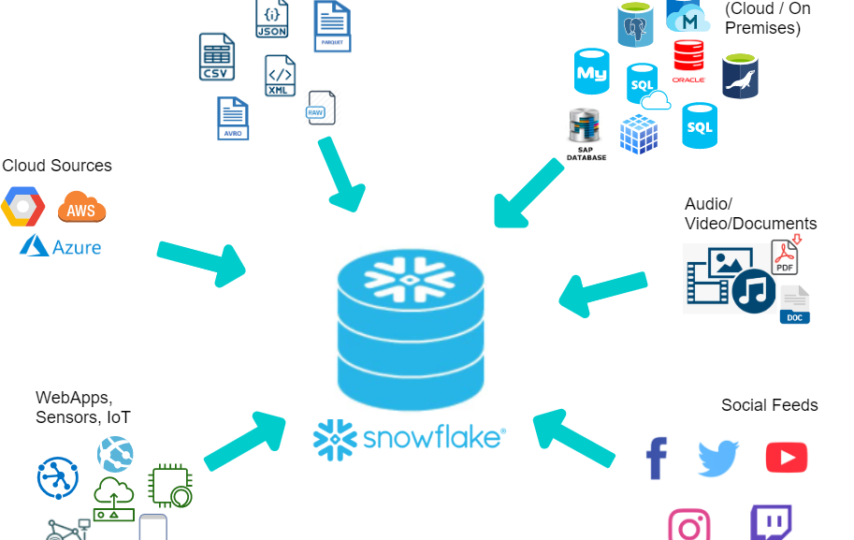Over time, Snowflake is becoming the go-to database for organizations across the board. More and more companies are trusting Snowflake for storing and analyzing their structured and unstructured datasets. The database allows users to make sense of their records and obtain valuable insights into the same. With its cloud-based functionality and robust architecture, Snowflake has carved its niche in the industry for its data storage and analytics capabilities.
In the age of digitization, it often becomes difficult for an organization to choose the right database and data warehouse to make sense of its records. This makes it important to compare different alternatives and zero in on the option that best suits your needs.
If you are thinking about implementing an ideal solution within your organization, here are the key features that make Snowflake different from other databases:
Ease Of Development
One of the biggest advantages Snowflake has over other databases is that it doesn’t require users to put in any more effort than required in the development environment. It provides you with a powerful and comprehensive UI that supports all major browsers, making development, implementation, and integration easier.
Two major competitors of Snowflake in this area are Azure Synapse Analytics and AWS Redshift. One of the major Redshift vs Snowflake differences is that while Redshift requires you to download a third-party SQL client like SQL Workbench, there are no such requirements to be met in the case of Snowflake. Moreover, Azure Synapse Analytics requires you to download SQL Server Management Studio, while there is no such need in the case of Snowflake.
Minimal Administration
Snowflake offers a near-zero administration as it is delivered as a Data Warehouse as a Service (DWaaS). This allows businesses to set up and manage a robust solution without the excessive involvement of database administrators and IT teams.
With Snowflake, there is no need to install any software or commission any hardware. Moreover, Snowflake eliminates the need for server size and cluster management by providing users with features like auto-scaling. This leads to an automated increase in the size of your virtual warehouse and clusters as per your requirements.
As no indexes are supported by Snowflake, there is no need for tuning your database or indexing your tables with the help of a database administrator. Moreover, all software updates are taken care of by Snowflake along with the deployment of new features with zero downtime. This helps you drive automation within your organization and helps you manage your database with minimal administration.
Cloud-agnostic Solutions
Snowflake provides organizations with cloud-agnostic solutions. Being a managed data warehouse solution, Snowflake is available on Amazon AWS, GCP, and Azure, while keeping the user experience intact. As per the needs of your organization, you can fit Snowflake into your existing cloud architecture and deploy it in specific regions that cater to your objectives.
High Scalability
In 2022, scalability plays a major role in choosing a database for your organization. Sporting a multi-cluster data architecture, Snowflake separates the computing and storage resources to increase the scalability of the solution. This allows users to scale up their resources when there is a need to load large volumes of datasets at a faster speed. Similarly, Snowflake allows users to scale the resources back down once the process is completed without hampering the service in any way.
This makes it possible for businesses to start with a really small database and expand the same as per their needs and circumstances. Moreover, as mentioned earlier, the data warehouse provides users with features like auto-scaling and auto-suspend. Auto-scaling allows users to start or stop clusters automatically when the resource-intensive processing gets unpredictable. Auto suspend allows users to stop the data warehouse when the clusters sit idle for a specific period of time.
Concurrency And Separation Of Workloads
In conventional databases, concurrency issues are common as users and processes compete for the available resources. This may require users to run ETL/ELT jobs when no one runs the reports. The multi-cluster architecture of Snowflake eliminates concurrency issues within an organization.
Moreover, one of the biggest benefits of Snowflake’s architecture is that it separates the workloads to be carried out against the compute clusters. Due to this, the queries arising out of one virtual warehouse (compute cluster) has no effect on the queries arising from another virtual warehouse.
Handling Semi-structured Data
Snowflake allows businesses to store, manage, and analyze semi-structured datasets. The need for handling semi-structured data (ideally in the JSON format) led to the increasing prominence of NoSQL database solutions. Developers needed to develop data pipelines for parsing JSON, extracting attributes, and combining them with structured data.
The multi-cluster architecture of Snowflake allows users to store structured as well as semi-structured data in the same destination with the help of a schema on a data type called VARIANT. VARIANT is capable of storing structured and semi-structured data. When users load data into the system, Snowflake parses it automatically, extracts necessary attributes from the same, and stores it in the system in a columnar format. This allows users to get rid of data extraction pipelines for getting the work done.
Greater Security
Implementation of cloud-based data warehouses comes with an inherent need for data security and privacy. Snowflake provides users with a range of powerful security features for keeping the system and data secure. It allows users to manage network policies by whitelisting the IP addresses. This restricts unwarranted access to specific accounts.
Moreover, the database supports a range of different authentication methods such as two-factor authentication and SSO. Snowflake controls the access to objects in an account with a hybrid discretionary access control model. Here, every object has a dedicated owner who grants access to the concerned object. All data stored and managed using Snowflake is encrypted via AES 256 encryption, with the data being encrypted while in transit and at rest.
The Final Word
These were some of the many features that make Snowflake stand out from the clutter. As you assess different alternatives for implementing the right database for your organization, make sure you consider the parameters mentioned above and select an alternative that is in sync with your organizational needs.





